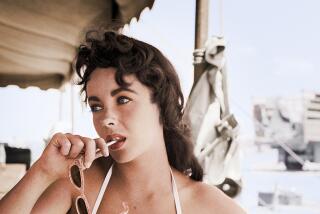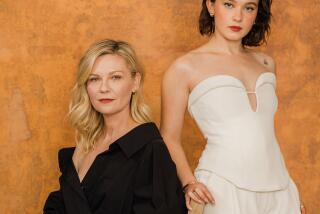A Portrait of an Evolving Career
- Share via
When audiences last saw Anjelica Huston, she had just fallen into a vat of purple dye, fitting punishment for the evil stepmother in the recent retelling of the Cinderella saga “Ever After.” Those tables are turned in her latest film, “Agnes Browne,” in which Huston stars as a down-to-earth widowed mother of seven in working-class Dublin, 1967. At story’s end, she emerges as something of a Cinderella figure herself.
Managing an on-screen brood that size and coping with the other crises that beset the movie’s heroine would be task enough, but Huston had more on her creative plate: She’s the film’s director as well as the star. It’s her debut as a feature film director (she directed the Showtime movie “Bastard Out of Carolina” in 1996), but taking on dual roles wasn’t her first choice.
“Agnes Browne” is based on the novel “The Mammy” by Brendan O’Carroll (who also co-wrote the screenplay), and when Huston first got involved in the project she didn’t intend to play the lead. In fact, she describes serving as her own director as “an act of madness.”
“I had an actress lined up to play Agnes, but she fell out of it at the last minute,” Huston says. “Taking on the lead role is something that I wouldn’t have considered had I not been under such pressure. I’m not that practiced as a director to begin with, so to have taken on that much willfully, I think, would have been tantamount to a certain form of masochism.”
In the USA Films release, which reopens Friday (it played for a week in December earning mostly favorable reviews), Agnes Browne finds herself unexpectedly widowed and “on the dole.” But she manages to hold her family together and keep her spirits up by selling produce at a local market, working side by side with her best friend, Marion (Marion O’Dwyer)--until another tragedy hits.
Huston talks about the film in her Venice office, a former gallery space connected via an alley exit with the home she shares with sculptor Robert Graham, her husband of nearly eight years. Dressed in a gray sweater and matching pants, the actress is tall, broad-shouldered, yet physically unimposing in contrast to her formidable screen presence. In conversation, Huston is direct and thoughtful about the details she chooses to share, well aware that much of her personal history is a matter of Hollywood lore.
“Someone wrote a biography about my family, and there even was some discussion for a while that it would become a miniseries. Mercifully, that all drizzled away,” she says of the enterprise. “But it was very odd, like being posthumous in your own time.”
Her office’s front entrance is flanked by two life-sized wooden mermaids that, she explains, once stood as ornaments on Mexican church organs. They later found their way to the bottom of the staircase at Saint Cleran’s, her father’s estate in the Irish countryside where Huston, 48, spent a decade of her childhood.
At 11, Huston moved to England with her mother, ballet dancer Enrica Soma. After her mother’s death in a car accident several years later, Huston returned to the U.S. She may have grown up in Ireland, but Huston’s Hollywood roots run three generations deep. Her grandfather, actor Walter Huston, had an illustrious film career that dated from the early years of the talkies through to his death in 1950, a year before Anjelica was born.
Her father, legendary director John Huston, had the singular distinction of directing both his father and daughter to Academy Awards: Walter’s supporting actor win came in 1948 for “The Treasure of the Sierra Madre” (John Huston also won for best director that year), and Anjelica won the supporting actress Oscar in 1985 for “Prizzi’s Honor.”
She starred in her father’s final directorial effort, “The Dead” (1987), an adaptation of the James Joyce novel written by her brother, Tony. She was killed in Woody Allen’s “Crimes and Misdemeanors” (1989) then resurrected in his “Manhattan Murder Mystery” (1993). But Huston is perhaps best known for her portrayals of extremely strong-willed, often over-the-top types such as Lilly Dillon in “The Grifters” (1990), the Grand High Witch in the 1990 adaptation of Roald Dahl’s “The Witches” and the spookily sensual Morticia Addams in “The Addams Family” (1991) and its 1993 sequel, “Addams Family Values.”
“I think a lot of why I first wanted to act was because I truly thought it was an exalted and glamorous life,” Huston says. She remembers being on the sets of her father’s films where “people were always hovering around the actresses. They seemed like immortal beings.”
Admittedly, much has changed since the so-called “golden age” of movie-making but, Huston claims, “there’s still a certain amount of fairy dust involved in the movie profession.”
Fairy dust wasn’t much in evidence, though, during the production of “Agnes Browne.” It was shot on location in Dublin, a city that has changed dramatically from the depressed era depicted in the film. Dublin is in the midst of an economic boom that has made it one of the most vital cities in Europe. Notes Huston: “Everywhere you look now there’s a crane and a skyscraper.”
In order to duplicate the film’s 1960s-era Market Street setting (which stood in for the real Moore Street Market), Huston and her crew used a street in the city’s less-developed Ringsend section. (According to USA Films, the budget for “Agnes Browne” was “under $20 million.”)
*
So, were the locals impressed by the arrival in their midst of a Hollywood movie star?
“Not one bit,” Huston recalls with a rueful laugh. “We were allowed to use this one street, as long as the merchants there were able to keep working. And when we were still working on Friday nights, they didn’t like it one bit, because we were stopping them from having a good time at the end of the week. We’d be trying to shoot, and the singing would start to get very, very loud in the pubs.”
On one particular occasion, she adds, “I was stuck in the booth in the ladies room and scared to come out, because there were two women there just slagging myself and Brendan O’Carroll off to such a degree, I was ashamed to show my face.”
‘They were a bit scalded that they couldn’t play their bingo,” recollects O’Dwyer, an Irish stage actress. O’Dwyer credits Huston for “helping me with the transition from theater to film. It was my very first film and it was a right baptism by fire of a part,” she says during a phone interview from Dublin. “Anjelica was just fabulous. Her belief in me gave me a lot of confidence,” which carried over into her on-screen portrayal.
“Agnes and Marion are strong, fearless women,” O’Dwyer relates. “It’s a tough life they’ve got, but they hold it together and even manage to have a sense of humor about things.”
Huston concurs. “Agnes is a decent woman who doesn’t have a lot of guile,” she says. “It was a nice adventure, the chance to play someone who’s basically very normal.”
That’s admittedly something of a change for Huston. “I think I usually play more worldly types. I like rarefied characters. And I like witches and extreme women and women with an edge, who would chew off their arm to get out of a trap.”
In her own way, Agnes Browne is as determined as any of the larger-than-life characters Huston has portrayed in the three dozen films in which she has appeared. In hearty middle-age, Agnes is stepping out onto a new path, using the strengths she’s developed in life to help her chart a new course. The same could be said of Huston, whose life experiences have helped her become more confident in her new career direction.
“I think there are certainly advantages to being me,” she remarks with her usual straightforward style. “And unless you make some hideous humdinger that everyone feels you should be ashamed of, it doesn’t hurt to be John Huston’s daughter. You have to take the slings and arrows that go along with the exalted position, but so far, so good. No one’s been particularly evil about me yet.”
Huston will be seen on-screen later this year in the Merchant Ivory adaptation of Henry James’ “The Golden Bowl,” playing the supporting role of Fanny. ‘Acting seems very relaxing to me since directing,” she confesses, comparing directing to “a huge caravan that you’re always pushing uphill.”
Huston says she hasn’t yet settled on her next project--or decided whether she’ll be in front of or behind the camera lens--or both.
“After ‘Bastard Out of Carolina,’ I think people looked to me for something radical the next time out,” she says. “But I didn’t want to come out of the same gate when I directed again. I’ve never done that as an actress. So who knows what it’ll be next time?”
More to Read
Only good movies
Get the Indie Focus newsletter, Mark Olsen's weekly guide to the world of cinema.
You may occasionally receive promotional content from the Los Angeles Times.










